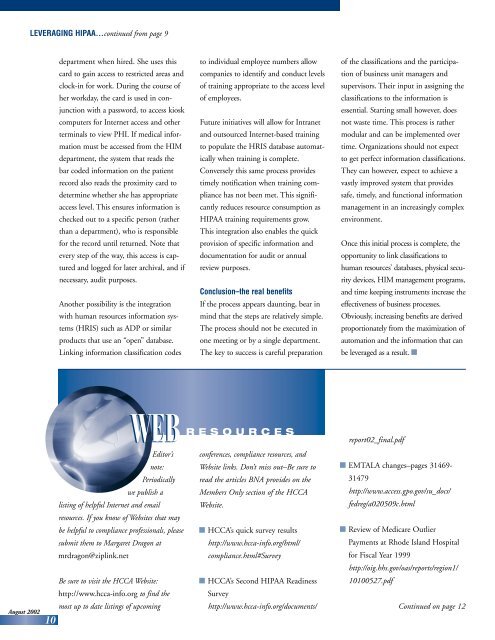JR - Health Care Compliance Association
JR - Health Care Compliance Association
JR - Health Care Compliance Association
Create successful ePaper yourself
Turn your PDF publications into a flip-book with our unique Google optimized e-Paper software.
LEVERAGING HIPAA...continued from page 9<br />
August 2002<br />
department when hired. She uses this to individual employee numbers allow<br />
card to gain access to restricted areas and companies to identify and conduct levels<br />
clock-in for work. During the course of of training appropriate to the access level<br />
her workday, the card is used in conjunction<br />
with a password, to access kiosk<br />
of employees.<br />
computers for Internet access and other Future initiatives will allow for Intranet<br />
terminals to view PHI. If medical information<br />
must be accessed from the HIM to populate the HRIS database automat-<br />
and outsourced Internet-based training<br />
department, the system that reads the ically when training is complete.<br />
bar coded information on the patient Conversely this same process provides<br />
record also reads the proximity card to timely notification when training compliance<br />
has not been met. This signifi-<br />
determine whether she has appropriate<br />
access level. This ensures information is cantly reduces resource consumption as<br />
checked out to a specific person (rather HIPAA training requirements grow.<br />
than a department), who is responsible This integration also enables the quick<br />
for the record until returned. Note that provision of specific information and<br />
every step of the way, this access is captured<br />
and logged for later archival, and if review purposes.<br />
documentation for audit or annual<br />
necessary, audit purposes.<br />
Conclusion–the real benefits<br />
Another possibility is the integration If the process appears daunting, bear in<br />
with human resources information systems<br />
(HRIS) such as ADP or similar The process should not be executed in<br />
mind that the steps are relatively simple.<br />
products that use an “open” database. one meeting or by a single department.<br />
Linking information classification codes The key to success is careful preparation<br />
WEB<br />
RESOURCES<br />
Editor’s conferences, compliance resources, and<br />
note: Website links. Don’t miss out–Be sure to<br />
Periodically read the articles BNA provides on the<br />
we publish a Members Only section of the HCCA<br />
listing of helpful Internet and email Website.<br />
resources. If you know of Websites that may<br />
be helpful to compliance professionals, please ■ HCCA’s quick survey results<br />
submit them to Margaret Dragon at<br />
http://www.hcca-info.org/html/<br />
mrdragon@ziplink.net<br />
compliance.html#Survey<br />
Be sure to visit the HCCA Website:<br />
■ HCCA’s Second HIPAA Readiness<br />
http://www.hcca-info.org to find the Survey<br />
most up to date listings of upcoming<br />
http://www.hcca-info.org/documents/<br />
10<br />
of the classifications and the participation<br />
of business unit managers and<br />
supervisors. Their input in assigning the<br />
classifications to the information is<br />
essential. Starting small however, does<br />
not waste time. This process is rather<br />
modular and can be implemented over<br />
time. Organizations should not expect<br />
to get perfect information classifications.<br />
They can however, expect to achieve a<br />
vastly improved system that provides<br />
safe, timely, and functional information<br />
management in an increasingly complex<br />
environment.<br />
Once this initial process is complete, the<br />
opportunity to link classifications to<br />
human resources’ databases, physical security<br />
devices, HIM management programs,<br />
and time keeping instruments increase the<br />
effectiveness of business processes.<br />
Obviously, increasing benefits are derived<br />
proportionately from the maximization of<br />
automation and the information that can<br />
be leveraged as a result. ■<br />
report02_final.pdf<br />
■ EMTALA changes–pages 31469-<br />
31479<br />
http://www.access.gpo.gov/su_docs/<br />
fedreg/a020509c.html<br />
■ Review of Medicare Outlier<br />
Payments at Rhode Island Hospital<br />
for Fiscal Year 1999<br />
http://oig.hhs.gov/oas/reports/region1/<br />
10100527.pdf<br />
Continued on page 12

















